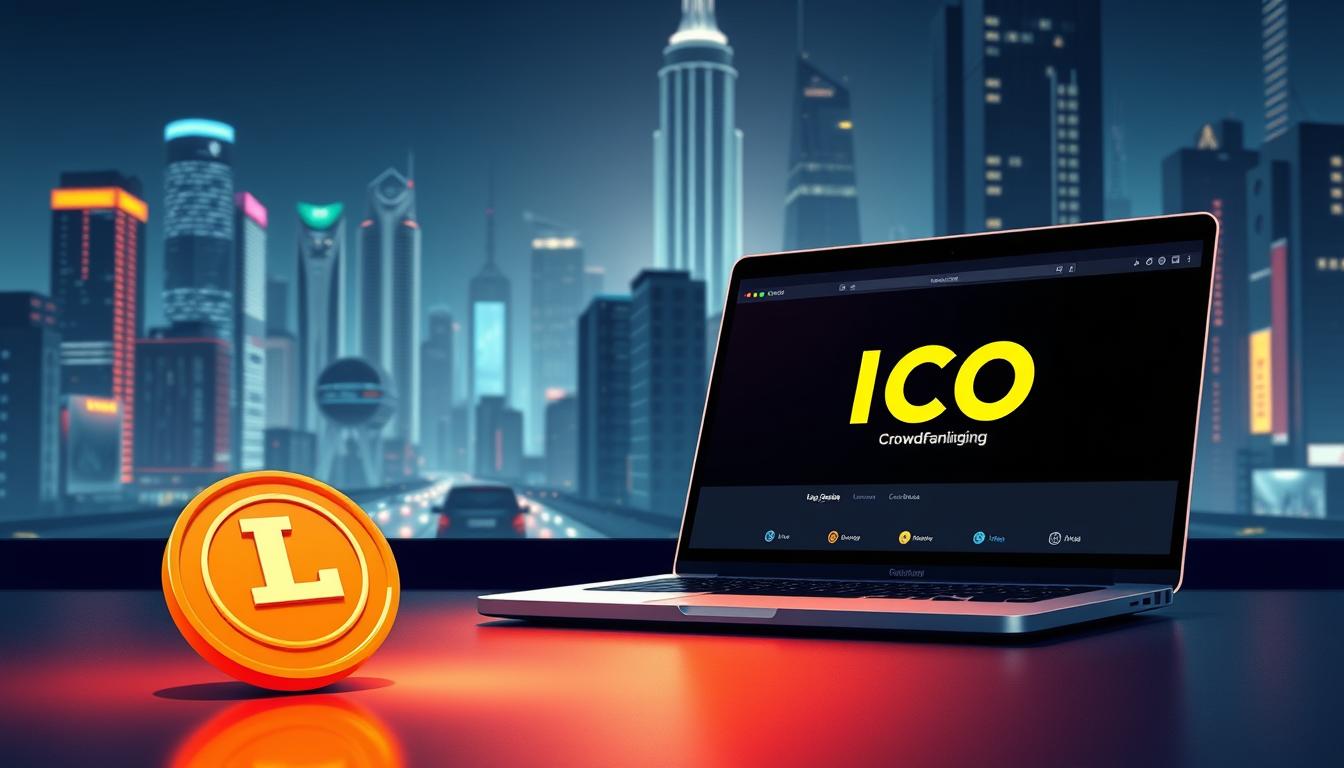Now Reading: The Beginner’s Guide to Initial Coin Offerings (ICOs)
- 01
The Beginner’s Guide to Initial Coin Offerings (ICOs)
The Beginner’s Guide to Initial Coin Offerings (ICOs)

Initial coin offerings, or ICOs, have become a popular method for startups and companies to raise funds through cryptocurrency fundraising. This article aims to provide a comprehensive guide on the subject, covering the basics of ICOs, including what they are, how they work, and their benefits and drawbacks. ICOs have revolutionized the way companies raise capital, offering a new alternative to traditional fundraising methods.
Through this guide, readers will gain a deeper understanding of Initial coin offerings and how they can be used to raise funds for various projects and ventures. The world of cryptocurrency fundraising is constantly evolving, and ICOs are at the forefront of this movement. By understanding the ins and outs of ICOs, individuals and companies can make informed decisions about their involvement in this exciting and rapidly growing field.
Understanding the Fundamentals of Initial Coin Offerings (ICOs)
Initial Coin Offerings (ICOs) have become a popular method of cryptocurrency fundraising, allowing companies to raise capital by issuing tokens to investors. ICOs differ from traditional fundraising methods in that they utilize blockchain technology and offer a decentralized approach to investing.
ICOs involve the creation and sale of new tokens, which can be used to access a particular product or service. This approach has gained popularity in recent years, with many companies using ICOs as a means of raising capital for their projects. The evolution of ICO fundraising has been rapid, with new platforms and technologies emerging to support this type of fundraising.
What Defines an ICO
An ICO is defined by its use of blockchain technology and the creation of new tokens. These tokens are typically issued in exchange for cryptocurrency, such as Bitcoin or Ethereum. The tokens can then be used to access a particular product or service, or they can be traded on cryptocurrency exchanges.
How ICOs Differ from Traditional Fundraising
ICOs differ from traditional fundraising methods in that they offer a decentralized approach to investing. With ICOs, investors can purchase tokens directly from the company, without the need for intermediaries. This approach has made it possible for companies to raise capital from a global pool of investors, rather than being limited to traditional funding sources.
The Evolution of ICO Fundraising
The evolution of ICO fundraising has been rapid, with new platforms and technologies emerging to support this type of fundraising. Today, ICOs are used by companies in a variety of industries, from finance to healthcare. As the use of ICOs continues to grow, it is likely that we will see further innovations in this area, including the development of new platforms and technologies to support ICO fundraising and token sales.
The Technology Behind ICO Tokens
Blockchain technology plays a crucial role in the creation and management of ICO tokens. Blockchain investments have become increasingly popular, offering a secure and transparent way to invest in digital assets. The use of smart contracts, decentralized ledgers, and cryptographic algorithms ensures the integrity and security of ICO transactions.
One of the key benefits of digital asset offerings is the ability to raise funds from a global pool of investors. This has opened up new opportunities for startups and entrepreneurs to access capital, bypassing traditional funding routes. The blockchain technology behind ICO tokens enables the creation of a decentralized and trustless system, where transactions are recorded on a public ledger.
The process of creating and managing ICO tokens involves several steps, including:
- Token design and development
- Smart contract implementation
- Blockchain integration
- Security audits and testing
These steps ensure that the ICO tokens are secure, functional, and compliant with regulatory requirements. As the demand forblockchain investmentsanddigital asset offeringscontinues to grow, it is essential to understand the technology behind ICO tokens and the benefits and risks associated with these investments.
| ICO Token Benefits | ICO Token Risks |
|---|---|
| Decentralized and trustless system | Regulatory uncertainty |
| Global access to funding | Security risks and hacking |
| Transparent and secure transactions | Market volatility and price fluctuations |
In conclusion, the technology behind ICO tokens is based on blockchain technology, which provides a secure and transparent way to invest in digital assets. As the market for blockchain investments and digital asset offerings continues to evolve, it is essential to stay informed about the benefits and risks associated with these investments.
Key Components of an ICO Launch
An Initial Coin Offering (ICO) launch involves several key components that are crucial to its success. These components include white paper development, token economics design, smart contract implementation, and marketing strategy. In the context of cryptocurrency fundraising, a well-planned ICO can attract significant investment and propel a project forward.
White Paper Development
A white paper is a detailed document that outlines a company’s business plan, technical specifications, and financial projections. It is essential for ICOs, as it provides potential investors with a clear understanding of the project and its potential for growth.
Token Economics Design
Token economics design refers to the process of creating a token that is both functional and valuable. This involves designing a token that has a clear use case and can be used to incentivize certain behaviors within the ecosystem. Effective token economics design is critical for the success of token sales and cryptocurrency fundraising.

Smart Contract Implementation
Smart contract implementation involves the use of self-executing contracts with the terms of the agreement written directly into lines of code. This ensures that the contract is executed automatically and transparently, reducing the need for intermediaries and increasing the security of the transaction.
Marketing Strategy
A well-planned marketing strategy is essential for the success of an ICO. This includes social media marketing, content marketing, and influencer marketing, all of which can help to raise awareness of the project and attract potential investors. By leveraging these marketing channels, companies can increase their visibility and reach a wider audience, ultimately driving more token sales and cryptocurrency fundraising.
| Component | Description |
|---|---|
| White Paper Development | Detailed document outlining business plan, technical specifications, and financial projections |
| Token Economics Design | Creating a functional and valuable token with a clear use case |
| Smart Contract Implementation | Self-executing contracts with terms written directly into lines of code |
| Marketing Strategy | Social media marketing, content marketing, and influencer marketing to raise awareness and attract investors |
How ICO Tokens Generate Value
ICO tokens generate value through various means, including blockchain investments and digital asset offerings. The value of an ICO token is typically determined by the company’s financial performance, the demand for the token, and the overall state of the cryptocurrency market. Investors can participate in blockchain investments to potentially earn returns.
Some ways ICO tokens can generate value include:
- Providing goods and services
- Creating a new market
- Speculation on the token’s future value
Investors should understand the risks and benefits associated with digital asset offerings and blockchain investments to make informed decisions. By doing so, they can potentially earn significant returns on their investments.
It is essential to conduct thorough research and due diligence before investing in ICO tokens. This includes evaluating the company’s financials, management team, and market potential. By taking a well-informed approach, investors can navigate the complex world of blockchain investments and digital asset offerings with confidence.
The ICO Investment Process
Investing in ICOs, or initial coin offerings, can be a complex process, but it can also be a lucrative way to participate in cryptocurrency fundraising. To get started, it’s essential to understand the different steps involved in the ICO investment process, including creating a crypto wallet, participating in token sales, and managing your ICO investments.
ICOs have become a popular method of cryptocurrency fundraising, allowing companies to raise capital by issuing tokens to investors. These tokens can be used to access the company’s products or services, or they can be traded on cryptocurrency exchanges.
Creating a Crypto Wallet
To participate in token sales, you’ll need a crypto wallet to store your tokens. There are several types of crypto wallets, including software wallets, hardware wallets, and paper wallets. Each type of wallet has its own advantages and disadvantages, and it’s essential to choose the right one for your needs.
Participating in Token Sales
Once you have a crypto wallet, you can participate in token sales. This typically involves sending cryptocurrency to the company’s wallet in exchange for tokens. It’s essential to do your due diligence before participating in a token sale, as the risks associated with investing in ICOs can be high.
Managing Your ICO Investments
After participating in a token sale, it’s essential to manage your ICO investments carefully. This includes monitoring the company’s progress, keeping track of your tokens, and making informed decisions about when to buy or sell. By following these steps and doing your research, you can make informed decisions about investing in ICOs and participating in cryptocurrency fundraising through token sales.
Evaluating ICO Projects
When considering blockchain investments, it’s essential to evaluate the project thoroughly. This includes assessing the company’s white paper, team experience, and market demand for the token. A well-structured white paper should provide a clear outline of the project’s goals, technology, and potential risks. The team’s experience and expertise in the field are also crucial in determining the project’s success.
In addition to these factors, it’s necessary to consider the risks associated with digital asset offerings. This includes regulatory changes, market volatility, and the risk of fraud. By conducting thorough research and due diligence, investors can make informed decisions about their blockchain investments. Some key factors to consider when evaluating ICO projects include:
- Team experience and expertise
- Market demand for the token
- Regulatory compliance
- Security measures in place
By carefully evaluating these factors, investors can minimize their risks and make informed decisions about their digital asset offerings. It’s also essential to stay up-to-date with the latest developments in the blockchain investments space to ensure you’re making the most informed decisions possible.
Legal and Regulatory Framework
The legal and regulatory framework surrounding ICOs is complex and varies by country. ICOs, as a form of cryptocurrency fundraising, are subject to different regulatory approaches. Some countries consider ICOs as securities offerings, while others view them as token sales. The regulatory environment for ICOs is constantly evolving, with new guidelines and laws being introduced to provide clarity and protection for investors.
Regulatory bodies are focusing on ensuring compliance with anti-money laundering and know-your-customer requirements. This includes implementing measures to prevent fraudulent activities and protect investors. The importance of transparency and disclosure in ICOs cannot be overstated, as it helps build trust with investors and regulatory bodies. Failure to comply with regulatory requirements can result in severe penalties, damaging the reputation of the project and its participants.
- Global ICO regulations: Countries are developing their own regulatory frameworks to govern ICOs, with some being more permissive than others.
- Compliance requirements: ICO projects must comply with various regulatory requirements, including anti-money laundering and know-your-customer laws.
- Investment restrictions: Some countries have imposed restrictions on who can invest in ICOs, such as accredited investors only.
In conclusion, the legal and regulatory framework for ICOs is a critical aspect of cryptocurrency fundraising and token sales. As the regulatory environment continues to evolve, it is essential for ICO projects to stay informed and comply with the relevant laws and regulations to ensure a successful and legitimate fundraising process.
| Country | Regulatory Approach | Compliance Requirements |
|---|---|---|
| United States | Securities laws apply | Registration with the SEC, anti-money laundering laws |
| European Union | Regulatory framework varies by country | Compliance with EU anti-money laundering laws, know-your-customer requirements |
Risk Assessment in ICO Investments
Investing in Initial Coin Offerings (ICOs) involves a range of risks, including market risk, liquidity risk, and regulatory risk. To mitigate these risks, it is essential to conduct thorough risk assessments, particularly when dealing with blockchain investments and digital asset offerings.
A key aspect of risk assessment is understanding the potential risks associated with ICOs. These risks can be categorized into several types, including:
- Market risk: The potential for fluctuations in the market to affect the value of the investment.
- Liquidity risk: The potential for difficulty in buying or selling the investment.
- Regulatory risk: The potential for changes in regulations to affect the investment.
To manage these risks, investors can use various strategies, such as diversification and ongoing monitoring. It is also crucial to stay informed about the latest developments in the blockchain investments and digital asset offerings space.
By conducting thorough risk assessments and using effective risk management strategies, investors can make more informed decisions when investing in ICOs and minimize their exposure to potential risks.
| Risk Type | Description |
|---|---|
| Market Risk | Potential for market fluctuations to affect investment value |
| Liquidity Risk | Potential for difficulty in buying or selling the investment |
| Regulatory Risk | Potential for changes in regulations to affect the investment |
ICO Marketing and Promotion Strategies
Effective marketing and promotion are crucial for the success of Initial Coin Offerings (ICOs). As a key component of cryptocurrency fundraising, ICOs require a well-planned strategy to reach potential investors and build a strong community. Token sales can be a highly competitive space, and a solid marketing approach can make all the difference.
To build a strong community, it’s essential to engage with potential investors through social media and create valuable content that showcases the benefits of the ICO. This can include blog posts, videos, and infographics that highlight the unique features and advantages of the cryptocurrency fundraising campaign. By leveraging social media presence, ICOs can increase their visibility and reach a wider audience.
Community Building
Community building is a critical aspect of ICO marketing. This involves creating a loyal group of supporters who believe in the project and are willing to invest in it. By building a strong community, ICOs can generate buzz and excitement around their token sales, which can help drive investment and increase the chances of success.

Social Media Presence
A strong social media presence is essential for ICO marketing. This includes creating profiles on platforms like Twitter, Facebook, and LinkedIn, and using them to share updates, news, and engaging content. By leveraging social media, ICOs can reach a wider audience and build a community of supporters who are interested in their cryptocurrency fundraising campaign.
Some key strategies for ICO marketing and promotion include:
- Building a strong community through social media and content creation
- Leveraging social media presence to increase visibility and reach a wider audience
- Partnering with influencers to promote the ICO and reach new investors
By following these strategies, ICOs can increase their chances of success and build a loyal community of supporters who believe in their project.
Technical Due Diligence
When it comes to blockchain investments, conducting thorough technical due diligence is crucial. This process involves assessing the company’s code, evaluating the token’s functionality, and reviewing the team’s technical expertise. For digital asset offerings, it’s essential to understand the underlying technology and its potential for growth.
To conduct technical due diligence, investors can use audits, review documentation, and test the token. This helps identify potential risks and ensures that the investment is sound. Some key aspects to consider include:
- Code quality and security
- Token functionality and scalability
- Team’s technical expertise and experience
By conducting thorough technical due diligence, investors can make informed decisions about their blockchain investments and digital asset offerings. This helps mitigate risks and ensures that the investment has the potential for long-term growth.
Post-ICO Token Management
After a successful Initial Coin Offering (ICO), the focus shifts to post-ICO token management. This critical phase involves several key aspects, including token distribution, exchange listings, and long-term value creation. Effective token management is crucial for the success of cryptocurrency fundraising and token sales.
Token distribution is a vital component of post-ICO token management. It involves allocating tokens to various stakeholders, including investors, team members, and advisors. Token vesting schedules are often used to ensure that tokens are released over a specified period, aligning with the project’s roadmap and milestones.
Token Distribution
- Token allocation to stakeholders
- Token vesting schedules
- Management of token holders
Exchange listings are another essential aspect of post-ICO token management. Listing tokens on reputable exchanges increases liquidity, visibility, and accessibility, making it easier for investors to buy and sell tokens. This, in turn, contributes to the growth and development of the cryptocurrency fundraising and token sales ecosystem.
Exchange Listings
Long-term value creation is the ultimate goal of post-ICO token management. It involves implementing strategies to increase token value, such as developing a strong community, improving the project’s technology, and expanding its use cases. By focusing on long-term value creation, ICOs can ensure the success and sustainability of their cryptocurrency fundraising and token sales initiatives.
Common ICO Scams and Red Flags
When investing in blockchain investments and digital asset offerings, it’s essential to be aware of common ICO scams and red flags. These scams can result in significant financial losses, damaging the reputation of legitimate ICO projects.
Some common types of scams include phishing scams, Ponzi schemes, and pump-and-dump schemes. To avoid falling victim to these scams, it’s crucial to conduct thorough research on the ICO project, including reviewing the white paper, understanding the token economics, and evaluating the team behind the project.
Red flags to watch out for include:
- Lack of transparency regarding the project’s goals, timeline, and budget
- Unrealistic promises of high returns with little to no risk
- Unclear or incomplete information about the token sale and distribution
Investors should be cautious when investing in digital asset offerings and blockchain investments, ensuring they verify the authenticity of the project and its team. By being aware of these common scams and red flags, investors can make informed decisions and avoid potential pitfalls.

It’s also important to note that legitimate ICO projects will provide clear and concise information about their project, including a well-structured white paper, a transparent token sale process, and a clear roadmap for the project’s development.
| Scam Type | Description |
|---|---|
| Phishing Scam | Scammers attempt to obtain sensitive information by posing as a legitimate ICO project |
| Ponzi Scheme | Scammers promise high returns with little to no risk, using funds from new investors to pay earlier investors |
| Pump-and-Dump Scheme | Scammers artificially inflate the price of a token by spreading false information, then sell their tokens at the inflated price |
Success Stories and Case Studies
ICOs, or initial coin offerings, have been a popular method of cryptocurrency fundraising in recent years. Many companies have successfully raised millions of dollars through token sales, while others have failed to reach their goals. In this section, we will explore some notable ICO launches and examine the factors that contributed to their success.
One key factor in the success of an ICO is the strength of the team behind it. A team with a proven track record and a clear vision for their project is more likely to attract investors and achieve their fundraising goals. Effective marketing strategies are also crucial, as they help to build a community of supporters and generate buzz around the project.
Notable ICO Launches
- Ethereum: This ICO raised over $18 million in 2014 and is now one of the largest and most well-established cryptocurrency platforms.
- Filecoin: This ICO raised over $257 million in 2017 and is a decentralized storage network.
- Tezos: This ICO raised over $232 million in 2017 and is a decentralized governance platform.
These success stories demonstrate the potential of ICOs as a means of cryptocurrency fundraising. By studying these examples and learning from the experiences of other companies, entrepreneurs can increase their chances of success with their own token sales.
Lessons from Failed Projects
While many ICOs have been successful, others have failed to reach their goals. By examining the reasons for these failures, companies can learn valuable lessons and avoid making the same mistakes. Some common pitfalls include poor marketing strategies, inadequate team experience, and a lack of clear goals or vision.
| ICO | Amount Raised | Reason for Failure |
|---|---|---|
| Example ICO | $1 million | Poor marketing strategy |
| Another ICO | $500,000 | Inadequate team experience |
By studying the successes and failures of other ICOs, companies can gain a better understanding of what it takes to succeed in the world of cryptocurrency fundraising and token sales.
Shaping the Future of Digital Fundraising
As the blockchain revolution continues to transform the financial landscape, the future of digital fundraising looks brighter than ever. Blockchain investments and digital asset offerings are paving the way for a more decentralized, transparent, and accessible capital-raising ecosystem. Companies are now leveraging the power of blockchain technology to create new asset classes, democratize access to investment opportunities, and streamline the fundraising process.
The emergence of decentralized finance (DeFi) platforms has opened up a world of possibilities for digital fundraising. Entrepreneurs can now tap into a global pool of investors, secure funding through innovative token sales, and build thriving communities around their projects. This shift towards decentralization is not only empowering startups but also giving everyday investors a chance to participate in the growth of groundbreaking ventures.
While the future of digital fundraising holds immense promise, it also comes with its share of challenges. Regulatory uncertainty, market volatility, and the need for ongoing innovation will require industry leaders to navigate uncharted waters. However, with a steadfast commitment to transparency, security, and financial inclusion, the digital fundraising landscape is poised to continue its meteoric rise, shaping the way companies and investors forge new pathways to success.
FAQ
What is an Initial Coin Offering (ICO)?
An Initial Coin Offering (ICO) is a type of crowdfunding campaign where a company issues digital tokens or coins in exchange for cryptocurrency, typically Bitcoin or Ethereum. ICOs have become a popular method for startups and companies to raise funds and launch new blockchain-based projects.
How do ICOs differ from traditional fundraising methods?
ICOs differ from traditional fundraising methods, such as venture capital or initial public offerings (IPOs), in several ways. ICOs are decentralized, allow for global participation, and typically do not involve the sale of equity in the company. Instead, investors receive digital tokens that can be used to access the company’s products or services or traded on cryptocurrency exchanges.
What is the role of blockchain technology in ICOs?
Blockchain technology plays a crucial role in ICOs. ICOs leverage blockchain’s decentralized and transparent nature to facilitate the issuance, distribution, and management of digital tokens. The use of smart contracts, which are self-executing contracts with the terms of the agreement written directly into code, is a key aspect of ICO implementation.
What are the key components of a successful ICO launch?
The key components of a successful ICO launch include the development of a comprehensive white paper, the design of a sustainable token economics model, the implementation of secure smart contracts, and the execution of an effective marketing strategy to attract investors and build a strong community.
How do ICO tokens generate value?
ICO tokens can generate value in several ways, including providing access to the company’s products or services, creating new markets, and speculation on the token’s future value. The value of an ICO token is typically determined by the company’s financial performance, the demand for the token, and the overall state of the cryptocurrency market.
What are the key steps in the ICO investment process?
The key steps in the ICO investment process include creating a secure cryptocurrency wallet, participating in token sales, and managing your ICO investments. It’s crucial to conduct thorough due diligence on the project, understand the risks involved, and diversify your investments to mitigate potential losses.
What are the legal and regulatory considerations for ICOs?
The legal and regulatory framework surrounding ICOs varies across different jurisdictions. Companies launching ICOs must comply with applicable securities laws, anti-money laundering regulations, and know-your-customer requirements. Failure to comply with these regulations can result in significant legal and financial consequences.
What are the common risks and red flags associated with ICOs?
Common risks and red flags associated with ICOs include market volatility, liquidity issues, regulatory uncertainty, and the potential for fraud or scams. Investors should be wary of projects with a lack of transparency, unrealistic promises, or an inexperienced team.
What are some notable success stories and lessons from failed ICO projects?
Some notable success stories of ICOs include projects that have successfully launched innovative products, built strong communities, and delivered long-term value to investors. Lessons from failed ICO projects include the importance of a robust technical foundation, effective marketing and community engagement, and adherence to regulatory requirements.
How is the future of digital fundraising being shaped by ICOs and blockchain technology?
The rise of ICOs and blockchain technology is transforming the landscape of digital fundraising. These technologies are enabling new models of crowdfunding, creating new asset classes, and democratizing access to capital. As the industry continues to evolve, ongoing innovation and responsible regulation will be crucial in shaping the future of this dynamic and rapidly changing space.

















